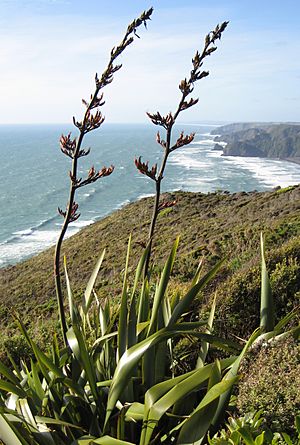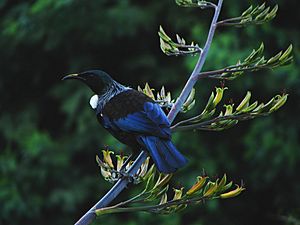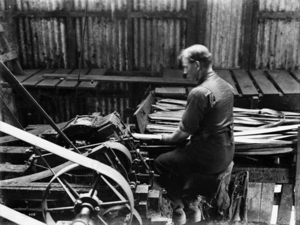New Zealand hemp facts for kids
Quick facts for kids New Zealand hemp |
|
|---|---|
 |
|
| Scientific classification | |
| Genus: |
Phormium
|
| Species: |
tenax
|

Phormium tenax, often called New Zealand flax, is a tall, green plant from New Zealand and Norfolk Island. In New Zealand, people simply call it flax, and in the Māori language, it's known as harakeke. This plant is super important because its strong fibres have been used for centuries. It's also a popular plant to grow in gardens because it looks so striking.
New Zealand flax grows in clumps with long, strap-like leaves that can reach up to two metres (about 6.5 feet) long. From these leaves, a much taller stalk grows, holding beautiful yellow or red flowers. The fibres from this plant have been used by Māori for a very long time to make textiles. Later, Europeans also used it for ropes and sails. Be careful though, the leaves contain natural chemicals called cucurbitacins, which can be bitter and are not good for some animals to eat.
Contents
Amazing Animals and Their Homes
New Zealand flax plants are important homes for some creatures. For example, a type of jumping spider called Trite planiceps loves to live inside the rolled-up leaves of this plant. Also, because Phormium tenax often grows near the coast, it provides important shelter for animals like the endangered yellow-eyed penguin. These penguins use the flax plants as a safe place to breed and raise their young.
Flax in Māori Culture
New Zealand flax was one of the most important plants for weaving before Europeans arrived in New Zealand. This was because it was easy to find everywhere and had very long, strong strands. Māori weavers could use harakeke in different ways. They could weave the leaves as they were, keeping the waterproof outer layer for things like open baskets. Or, they could process the leaves to get out the soft inner fibre called muka, which was used for finely woven items.
Māori people even had special areas where they grew flax. They would cut the green leaves near the bottom, then split them and weave them. Depending on how they prepared the leaves, the material could be used for tough, flat items like kete (baskets) and mats. It could also be made into strong twine for ropes or soft, beautiful fabric for cloaks.
To make the flax strips white, Māori would boil them with hot stones. It was tricky to dye the fibre because of its waterproof outer layer. However, they found that using paru, a special iron-rich mud, could dye the flax. They also had a technique called hapine, where they would run a knife or shell over the fibre. This helped remove moisture and made the flax more flexible without breaking it.
Growing New Zealand Flax
New Zealand flax was incredibly useful in traditional Māori society. It became the main material for weaving after another traditional fabric plant from Polynesia, called aute (paper mulberry), didn't grow well in New Zealand's climate. Many of the old ways of using flax are not as common today. However, there's a growing interest in using traditional materials in modern Māori art and crafts.
Two main ways flax is used in traditional crafts are:
- Using dried, stripped leaves as wide bands for weaving kete (flax baskets).
- Scraping, pounding, and washing the leaves to create muka fibre. This soft, strong fibre is used in tāniko weaving to make durable clothing.
Flax is also used as a beautiful and strong part of tukutuku panels, which are decorative panels found inside Māori wharenui (meeting houses).
In the past, before the 1930s, people tried to grow flax specifically for its fibre. For example, Leonard Cockayne in Wellington worked on this around 1908. Later, John Stuart Yeates at Massey University also tried in the late 1920s. New Zealand flax was even grown on Saint Helena from the late 1800s until about 1966 to make string and rope for export. Today, the plants are still there, but the industry has stopped.
Flax in Your Garden
Today, Phormium tenax and its relative P. colensoi are very popular garden plants. Their cool, fan-shaped leaves make a great focal point in gardens or next to a lawn. They are quite easy to grow in a sunny spot, especially near the coast. They like soil that stays moist. You might see them in garden centres next to plants like Yucca and Cordyline, but these are different plants with different needs. Some types of P. tenax can grow very large, up to 4 metres (about 13 feet) tall and 2 metres (about 6.5 feet) wide!
Cool Types of Flax
Many different types of Phormium have been created for gardens. Here are a few popular ones:
- 'Bronze Baby' - Has arching bronze leaves and grows to about 2 to 3 feet tall.
- 'Dazzler' - Features arching leaves that are bronze-maroon with red and pink stripes. This plant reaches about 3 feet tall.
- 'Duet'agm
- Purpureum Groupagm
- 'Sundowner'agm - A tall plant, about 6 feet high, with leaves striped in bronze, green, and rose-pink.
- 'Variegatum'agm
- 'Yellow Wave'agm
The ones marked agm have won the Royal Horticultural Society's Award of Garden Merit. This award means they are excellent plants for gardens.
Images for kids
-
A Tui bird on New Zealand flax.
See also
 In Spanish: Phormium tenax para niños
In Spanish: Phormium tenax para niños
- Phormium, which talks about both types of flax plants.
- Flax in New Zealand



